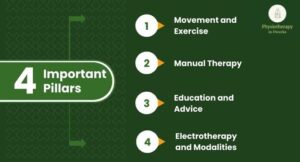Ever felt like your body just isn’t cooperating after an injury, surgery, or even long hours at a desk? Well, that’s where physiotherapy swoops in like a quiet hero. The truth is, healing isn’t just about rest, it’s about guided movement, rebuilding strength, and retraining your body to function better than before. And guess what? There isn’t just one way to do it. In fact, understanding the Types of Physiotherapy can help you figure out which path suits your recovery journey best. Trusted centers like Physiotherapy in dwarka specialize in offering multiple approaches tailored to individual needs.
What Are the Four Main Types of Physical Therapy?
When people hear “physiotherapy,” they often imagine simple exercises and stretches. But hang on a sec, it’s way broader than that. Physiotherapy branches into several specialized approaches, each designed to tackle different needs. Let’s break down the four main types of physical therapy that often take center stage:
- Orthopedic Physiotherapy – Think of bone breaks, sprains, joint problems, or post-surgery rehab. This type focuses on getting you back on your feet, literally through strength training, joint mobilization, and manual therapy.
- Neurological Physiotherapy – Conditions like stroke, multiple sclerosis, or spinal cord injuries don’t just affect the brain or nerves, they affect movement. This therapy helps retrain your nervous system to regain balance, mobility, and coordination.
- Cardiopulmonary Physiotherapy – Ever seen someone recovering from heart surgery or a serious respiratory illness? This type of therapy boosts lung capacity, strengthens the heart, and teaches energy-conserving techniques for better daily living.
- Pediatric Physiotherapy – Growing bodies need special attention. Kids with developmental delays, cerebral palsy, or muscular issues benefit from therapies that build coordination, posture, and confidence in movement.
These four branches are just the tip of the iceberg, but they lay the foundation for most treatment plans. At Physiotherapy in dwarka , all these approaches are provided under one roof, ensuring that patients get comprehensive and personalized care.
What Are the 4 Pillars of Physiotherapy?

Now that we’ve touched the branches, let’s dive into the philosophy behind them. Many physiotherapists swear by the 4 pillars of physiotherapy, which act like guiding lights in every treatment plan. So, what are they?
- Movement and Exercise – No surprises here. Whether it’s gentle stretching or resistance training, controlled exercise helps restore muscle balance, improve mobility, and prevent re-injury.
- Manual Therapy – Ever had a therapist work directly on your joints or muscles with their hands? That’s manual therapy. It improves circulation, reduces stiffness, and helps break down scar tissue.
- Education and Advice – Physiotherapy isn’t just about what happens in the clinic. Patients are taught posture correction, ergonomic tips, and lifestyle hacks to manage or prevent pain.
- Electrotherapy and Modalities – From ultrasound waves to electrical stimulation, these tools reduce pain and speed up healing. While they sound high-tech, they’re often combined with exercise and manual care for maximum results.
Together, these pillars ensure physiotherapy isn’t a one-size-fits-all solution, it’s tailored to your body, your condition, and your goals.
Beyond the Basics: Other Noteworthy Approaches
Physiotherapy is like a vast ocean, you discover more the deeper you dive. Aside from the big four, here are a few other remarkable therapies worth mentioning:
- Geriatric Physiotherapy – Focused on seniors, this approach manages arthritis, balance issues, and mobility so aging feels less like slowing down and more like thriving.
- Sports Physiotherapy – Tailored for athletes, it deals with injury prevention, recovery, and performance optimization.
- Vestibular Therapy – Dizziness or balance issues? This therapy retrains your inner ear system to improve stability.
- Women’s Health Physiotherapy – Targets conditions like pregnancy-related back pain, postpartum recovery, and pelvic floor dysfunction.
Each of these types adds another layer to how physiotherapy supports different bodies at different stages of life. Clinics like Physiotherapy in dwarka often blend these therapies to create holistic treatment plans for patients of all ages.
Why Does Choosing the Right Physiotherapy Matter?
You wouldn’t use the same workout for a marathon runner and a weightlifter, right? The same logic applies here. Picking the right physiotherapy approach means faster recovery, fewer complications, and in many cases, long-term freedom from recurring pain. It’s not just about fixing what’s broken, it’s about creating resilience for the future.
FAQs
Q1: What are the four main types of physical therapy?
The four main types include orthopedic, neurological, cardiopulmonary, and pediatric physiotherapy, each targeting different recovery needs.
Q2: What are the 4 pillars of physiotherapy?
The pillars are movement and exercise, manual therapy, education, and electrotherapy, together forming the foundation of treatment.
Q3: How long does physiotherapy usually take to show results?
It depends on the condition. Some patients see improvements within weeks, while others may need months of consistent care.
Q4: Can physiotherapy replace surgery?
In some cases, yes. Physiotherapy can help manage pain, restore function, and sometimes delay or eliminate the need for surgery.
Q5: Is physiotherapy safe for all age groups?
Absolutely! From infants to seniors, physiotherapy adapts to each age group’s unique needs.
Conclusion
Physiotherapy isn’t just about exercises in a clinic, it’s about reclaiming control of your body. Once you understand the Types of Physiotherapy, it’s easier to see how each one fits into different stages of recovery and health goals. Whether you’re bouncing back from an accident, fighting chronic pain, or just trying to move better, physiotherapy is like a road map guiding you toward a healthier, stronger version of yourself.

